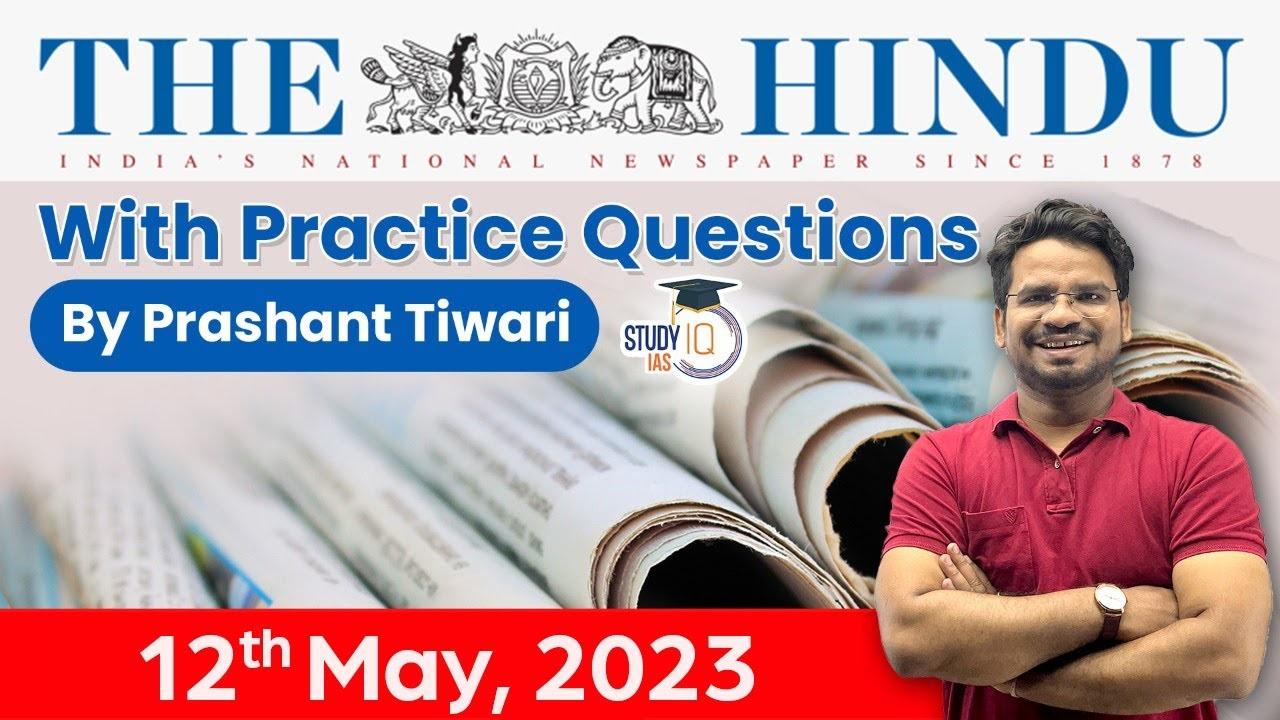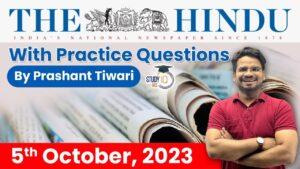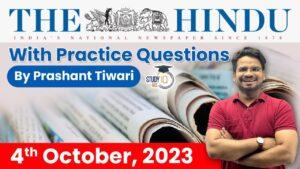The Hindu Newspaper Analysis for UPSC

The Hindu Newspaper Analysis 11 May 2023

- the Supreme Court has settled the law in regard to the ‘aid and advice’ of the Council of Ministers by affirming that the Lt. Governor is bound to act on the aid and advice except in respect of ‘Land’, ‘Public Order’ and the ‘Police’.
- The Court has also made it clear that there is no requirement of the concurrence of the Lt. Governor and that he has no power to overrule the decisions of the State government.
- However, there is a catch here — in the operationalisation of Article 239AA (4) ( proviso ) which says that in the case of a difference of opinion between the Lt. Governor and his Ministers on any matter, the Lt. Governor shall refer it to the President for decision and act according to that decision.
- The status of Delhi being a Union Territory under Schedule 1 of the Constitution but christened the ‘National Capital Territory’ under Article 239AA.
- The 69th amendment to the Constitution of India inserted Article 239AA, which declared the Union Territory of Delhi to be administered by a L-G who works on aid and advice of the elected legislative assembly.
- Further, the Article 239AA also notes that L-G has to either act on the aid and advice of the Council of Ministers, or he is bound to implement the decision taken by the President on a reference being made by him.
- Also, Article 239AA, empowers the L-G to refer a difference of opinion on ‘any matter’ with the Council of Ministers to the President.
- Thus, this dual control between L-G and the elected government leads to a power tussle.

- In Nabam Rebia case (2016), the SC held that a speaker will be disabled from deciding disqualification petitions under the anti-defection law (10th schedule of the constitution) if a notice for their removal is pending.
- The anti-defection law punishes individual Members of Parliament (MPs)/MLAs for leaving one party for another.
- Parliament added it to the Constitution as the Tenth Schedule in 1985. Its purpose was to bring stability to governments by discouraging legislators from changing parties.
- The Tenth Schedule – popularly known as the Anti-Defection Act – was included in the Constitution via the 52nd Amendment Act, 1985.
- Voluntary Give Up:
- If an elected member voluntarily gives up his membership of a political party.
- Violation of Instructions:
- If he votes or abstains from voting in such House contrary to any direction issued by his political party or anyone authorized to do so, without obtaining prior permission.
- As a pre-condition for his disqualification, his abstention from voting should not be condoned by his party or the authorized person within 15 days of such incident.
- Elected Member:
- If any independently elected member joins any political party.
- Nominated Member:
- If any nominated member joins any political party after the expiry of six months.
About the Role of a Whip:
- A whip is an official of a political party whose task is to ensure party discipline in the legislature.
- Whips are the party’s “enforcers”.
- The whip ensures that the members of the political party vote according to the party, rather than according to their own individual ideology or the will of their donors or constituents.
- Every political party, whether ruling or Opposition has its own whip in the Parliament.
- He is appointed by the political party and serves as an assistant floor leader.
- Under the Tenth Schedule (anti-defection law) a political party has a constitutional right to issue a whip to its legislators.

- India has increasingly used varied symbolic instruments of power to enhance its soft power appeal. Prime Minister Narendra Modi now projects India as the “mother of democracies” and as a “moral force” to enforce global peace.
- The regular Modi-Zelenskyy interactions may be seen as underscoring India’s rising stature and recognition of its unique position in the emerging global order, despite western criticism of India’s continued energy imports from Russia and export of excess refined Russian fuel to the European market.
- While New Delhi has expressed its disapproval of the Ukraine war, it has avoided taking a clear position in many UN resolutions on the issue. This may be understandable as India has often taken an evasive position on conflicts that involve its traditional allies.
- A pursuit of ‘multi-alignment’ may have given New Delhi some diplomatic space in the ongoing war in Ukraine.
- However, it may not be sufficient for India to try to play the role of a mediator between Russia and Ukraine. India currently lacks the material resources to match the extent of China’s economic and military potential.
- China’s recent mediation efforts to resolve the Ukraine crisis have once again spotlighted India’s approach to conflict resolution.

- After almost 70 years, the Special Marriage Act still has fewer takers due to political campaigns, bureaucratic overreach and the general misconception that it only caters to inter-religious couples.
- And a study of this law’s implementation discredits the doomsday predictions of those who continue to oppose marriage reform. Social transformations are not easy and laws, in a vacuum, are unlikely to disrupt the lives of ‘vast majorities’.
- Some citizens may not be prepared for marriage equality, just as some are not open to inter-caste and inter-community marriages but, as Pandit had argued in 1954, the law should hold out more potential than the public imagination allows for and should be aimed at improving the lives of the more marginalised.
- Affording rights to a sexual minority — even if it is a minority — reaffirms the rights of the citizenry as a whole.

About Cham
- Origin: The Yogachara School of Buddhism was founded in Kashmir in the 4th century by Asanga and Vasubandhu. This developed into the sophisticated Vajrayana form of Buddhism, which incorporated the Cham dance.
- From Ladakh to Mongolia, the Cham is the deepest form of meditation of the Lamas.
- The purpose of this meditation is for the Lama (priest) to be able to free himself entirely from his own ephemeral personality.
- It was started in the eighth century by Padmasambhava (who introduced Tantric Buddhism to Tibet), to subjugate the local demons that were obstructing the building of the first monastery in Tibet, Samye.
- It is an elaborate masked and Costumed dance. It is considered an act of cleansing evil forces.
- It is unique to Tibetan Buddhism and an important cultural tradition.
Q) ‘Coco Islands’, recently seen in the news, lies in which one of the following seas?
- Arabian Sea
- Baltic Sea
- South China Sea
- Bay of Bengal
हाल ही में समाचारों में देखा गया ‘कोको द्वीप’ निम्नलिखित में से किस समुद्र में स्थित है?
- अरब सागर
- बाल्टिक सागर
- दक्षिण चीन सागर
- बंगाल की खाड़ी
About Coco Islands:
- They are a small group of islands located in the Bay of Bengal.
- Great Coco Island, the largest in the group, lies just 55 km from India’s strategic Andaman and Nicobar Islands.
- They are part of the Yangon Region of Myanmar.
- It is geologically an extended division of the Arakan Mountains or Rakhine Mountains, submerges as a chain of islands in the Bay of Bengal for a long stretch and emerges again in the form of the Andaman and Nicobar Islands.
- They are part of the same topography as India’s Andaman & Nicobar Islands.

Q) Consider the following statements regarding Rabindranath Tagore:
- He was the first non-European to receive the Nobel Prize for Literature.
- He was the son of Satyendranath Tagore, a prominent social reformer.
Which of the above statements is/are correct?
- 1 only
- 2 only
- Both 1 and 2
- Neither 1 nor 2
रवींद्रनाथ टैगोर के संबंध में निम्नलिखित कथनों पर विचार करें:
- वे साहित्य के लिए नोबेल पुरस्कार पाने वाले पहले गैर-यूरोपीय थे।
- वह एक प्रमुख समाज सुधारक सत्येंद्रनाथ टैगोर के पुत्र थे।
उपरोक्त कथनों में से कौन-सा/से सही है/हैं?
- केवल 1
- केवल 2
- 1 और 2 दोनों
- न तो 1 और न ही 2
About Rabindranath Tagore:
- He was a world-renowned poet, litterateur, philosopher and Asia’s first Nobel laureate.
- He was born in Kolkata on May 7, 1861.
- He was the son of Debendranath Tagore, a prominent philosopher and religious reformer.
- He was popularly known as Bard of Bengal, and people used to call him Gurudev.
- He introduced new prose and verse forms and the use of colloquial language into Bengali literature, thereby freeing it from traditional models based on classical Sanskrit.
- He was highly influential in introducing Indian culture to the West and vice versa.
- In 1913 he became the first non-European to receive the Nobel Prize for Literature.
- He was also an influential artist and musician. He wrote around 2230 songs and painted 3000 paintings. His songs are known as Rabindra Sangeet.
- Rabindranath Tagore wrote India’s national anthem, Jana Gana Mana. He also wrote Amar Sonar Bangla, the national anthem for Bangladesh. The Sri Lankan national anthem was inspired by his work.
- He was awarded a knighthood in 1915, but he repudiated it in 1919 as a protest against the Amritsar (Jallianwalla Bagh) Massacre.
- Viswa Bharti University, which was known as Shantiniketan founded by Rabindranath Tagore.
Q) Consider the following statements regarding the Geological Survey of India (GSI):
- It remains the principal agency for geological mapping and regional mineral resources assessment of the country.
- It is an attached office to the Ministry of Petroleum and Natural Gas.
Which of the above statements is/are correct?
- 1 only
- 2 only
- Both 1 and 2
- Neither 1 nor 2
भारतीय भूवैज्ञानिक सर्वेक्षण (GSI) के संबंध में निम्नलिखित कथनों पर विचार करें:
- यह देश के भूवैज्ञानिक मानचित्रण और क्षेत्रीय खनिज संसाधनों के आकलन के लिए प्रमुख एजेंसी बनी हुई है।
- यह पेट्रोलियम और प्राकृतिक गैस मंत्रालय से संबद्ध कार्यालय है।
उपरोक्त कथनों में से कौन-सा/से सही है/हैं?
- केवल 1
- केवल 2
- 1 और 2 दोनों
- न तो 1 और न ही 2
About Geological Survey of India (GSI):
- It was set up in 1851 primarily to find coal deposits for the Railways.
- Over the years, it has grown into a repository of geo-science information required in various fields in the country.
- Objective: Providing objective, impartial and up-to-date geological expertise and geoscientific information of all kinds, with a focus on policy-making decisions and commercial and socio-economic needs.
- Under the National Mineral Policy (NMP) 2008, GSI remains the principal agency for geological mapping and regional mineral resources assessment of the country.
- It also emphasises systematic documentation of all geological processes, both surface and subsurface, of India and its offshore areas.
- The organisation carries out this work through geological, geophysical, & geochemical surveys using the latest and most cost-effective techniques and methodologies.
- It is headquartered in Kolkata and has six regional offices located at Lucknow, Jaipur, Nagpur, Hyderabad, Shillong and Kolkata. Every state has a state unit.
- Presently, GSI is an attached office to the Ministry of Mines.
Q) Consider the following statements regarding National Tiger Conservation Authority (NTCA):
- It is a statutory body under the Ministry of Environment, Forest, and Climate Change (MoEFCC).
- The Secretary of MoEFCC acts as the Chairperson of NTCA.
Which of the above statements is/are correct?
- 1 only
- 2 only
- Both 1 and 2
- Neither 1 nor 2
राष्ट्रीय बाघ संरक्षण प्राधिकरण (NTCA) के संबंध में निम्नलिखित कथनों पर विचार करें:
- यह पर्यावरण, वन और जलवायु परिवर्तन मंत्रालय (MoEFCC) के तहत एक वैधानिक निकाय है।
- एमओईएफसीसी के सचिव एनटीसीए के अध्यक्ष के रूप में कार्य करते हैं।
उपरोक्त कथनों में से कौन-सा/से सही है/हैं?
- केवल 1
- केवल 2
- 1 और 2 दोनों
- न तो 1 और न ही 2
About National Tiger Conservation Authority (NTCA):
- It is a statutory body under the Ministry of Environment, Forest, and Climate Change (MoEFCC).
- It was established in 2006 under Wildlife (Protection) Act 1972.
- Objectives:
- Providing statutory authority to Project Tiger so that compliance of its directives becomes legal.
- Fostering accountability of Center-State in management of Tiger Reserves by providing a basis for MoU with States within the federal structure.
- Providing for an oversight by Parliament.
- Addressing livelihood interests of local people in areas surrounding Tiger Reserves.
- NTCA Composition:
- Minister in charge of MoEFCC (as Chairperson),
- Minister of State in MoEFCC (as Vice-Chairperson),
- three members of Parliament, the Secretary (MoEFCC), and other members.


 The Hindu Newspaper Analysis 6 October 2...
The Hindu Newspaper Analysis 6 October 2...
 The Hindu Newspaper Analysis 5 October 2...
The Hindu Newspaper Analysis 5 October 2...
 The Hindu Newspaper Analysis 4 October 2...
The Hindu Newspaper Analysis 4 October 2...

















